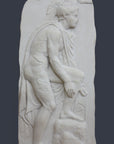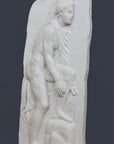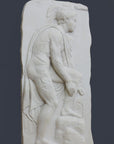


Parthenon Fragment - Item #16
38 Inches High x 18 Inches Wide x 4 Inches Deep
The Parthenon, a temple dedicated to the goddess Athena, is an astounding example of Classical Greek architecture and art. It was built by the architects Ictinus and Callicrates while the supervisor, and also the artistic director, for the project was the sculptor Phidias. Situated on the Acropolis in Athens, the Parthenon, at its prime, was a temple of white marble with countless colorful sculptures. Today, it is partially in ruins. The frieze that surrounded the cella, or the interior structure, still exists, but is divided among many museums around the world. The Acropolis Museum and the British Museum hold the majority of the 115 blocks, which formed the 160 meter- (or 525 foot-) long frieze. The narrative is about the procession that took place on the final day of the festival that honored Athena, the Great Panathenaia.
This piece is a reduction of a fragment from slab VI of the western side of the frieze. The imagery shares a similarity with that of slab XV: in each, a youth pauses during the procession to tie his sandal, and is turned toward the on-coming procession. The motive for this composition was to add variety within the long line of horses.
Artist: Unknown
Museum: Acropolis Museum, Athens
Origin: The Parthenon - Western Frieze, Athens
Time Period: Ancient Greek, 447-432 B.C.E.
Sources:
Choremi, A. “The Parthenon Frieze. Block W VI.” The Parthenon Frieze. English translation by M. Caskey. Ministry of Culture – Acropolis Restoration Service – First Ephorate of Prehistoric and Classical Antiquities – Department of Information and Education, and National Documentation Centre – National Hellenic Research Foundation, 2009, http://repository.parthenonfrieze.gr/frieze/handle/10442/wvi.
“The Frieze.” Acropolis Museum, http://www.theacropolismuseum.gr/en/content/frieze-0.
Hadziaslani, C. and I. Kaimara. “About Parthenon.” The Parthenon Frieze. English translation by M. Caskey. Ministry of Culture – Acropolis Restoration Service – First Ephorate of Prehistoric and Classical Antiquities – Department of Information and Education, and National Documentation Centre – National Hellenic Research Foundation, 2009, http://repository.parthenonfrieze.gr/frieze/aboutParthenon.jsp.
“Parthenon.” Wikipedia, https://en.wikipedia.org/wiki/Parthenon#Architecture.
Pieces are plaster unless otherwise noted. They are made to order and hand cast. We offer our pieces in a variety of patinas/finishes.
Masks and small and large reliefs (except tabletop pieces as noted) come with at least one embedded hook for hanging unless otherwise noted. For all other pieces, like anatomical casts, refer to the product pages.
Questions? View the FAQ page for more information and for answers to frequently asked questions. Email us at contact@capronicollection.com or call us at 781-933-2455.
View the patina/finish options for your hand-made reproduction here or above. Be sure to make your selection when adding the item to your cart.
Most items ship within a few days to 3 weeks as our reproductions are made to order and hand cast.
Customers in the contiguous United States receive free ground shipping automatically at checkout. Note that an oversized item – typically an item weighing more than 150 pounds when packaged – will not populate a shipping rate because it may have to ship via a freight carrier. In this case, please contact us for a quote. Customers in Alaska, Hawaii, and the U.S. territories and international customers can find shipping options in the checkout process.
Items must be opened and inspected within 48 hours of delivery to report any damage.
Returns are not accepted; all sales are final as pieces are made to order and hand cast.
More info and answers to frequently asked questions can be found under FAQ.













